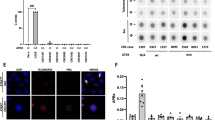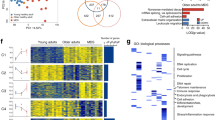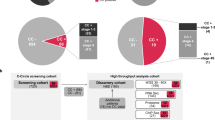Abstract
Telomere loss is rapid during the progression of chronic myeloid leukaemia (CML) and correlates with prognosis. We therefore sought to measure expression of the major telomerase components (hTR and hTERT) in CD34+ cells from CML patients and normal controls, to determine if their altered expression may contribute to telomere attrition in vivo. High-purity (median 94.1%) BCR-ABL+ CD34+ cells from CML (n=16) and non-CML (n=14) patients were used. CML samples had a small increase in telomerase activity (TA) compared to normal samples (approximately 1.5-fold, P=0.004), which was inversely correlated with the percentage of G0 cells (P=0.02) suggesting TA may not be elevated on a cell-to-cell basis in CML. Consistent with this, hTERT mRNA expression was not significantly elevated; however, altered mRNA splicing appeared to play a significant role in determining overall full length, functional hTERT levels. Interestingly, Q-RT-PCR for hTR demonstrated a mean five-fold reduction in levels in the chronic phase (CP) CML samples (P=0.002), raising the possibility that telomere homeostasis is disrupted in CML. In summary, the molecular events regulating telomerase gene expression and telomere maintenance during the CP of CML may influence the disease progression observed in these patients.
This is a preview of subscription content, access via your institution
Access options
Subscribe to this journal
Receive 12 print issues and online access
$259.00 per year
only $21.58 per issue
Buy this article
- Purchase on Springer Link
- Instant access to full article PDF
Prices may be subject to local taxes which are calculated during checkout







Similar content being viewed by others
References
Sawyers CL . Chronic myeloid leukemia. N Eng J Med 1999; 340: 1330–1340.
Holyoake T . Recent advances in the molecular and cellular biology of CML: lessons to be learned from the laboratory. Br J Haematol 2001; 113: 11–23.
Ichimaru M, Ishimaru T, Mikami M, Yamada Y, Ohkita T . Incidence of leukemia in a fixed cohort of atomic bomb survivors and controls, Hiroshima and Nagasaki, October 1950–December 1978. Technical Report RERF TR 13-81. Hiroshima: Radiation Effects Research Foundation, 1981.
Brummendorf TH, Holyoake TL, Rufer N, Barnett MJ, Schulzer M, Eaves CJ et al. Prognostic implications of differences in telomere length between normal and malignant cells from patients with chronic myeloid leukemia measured by flow cytometry. Blood 2000; 95: 1883–1890.
Drummond M, Lennard A, Bruemmendorf T, Holyoake T . Telomere shortening correlates with prognostic score at diagnosis and proceeds rapidly during progression of chronic myeloid leukemia. Leuk Lymphoma 2004; 45: 1775–1781.
Kim NW, Piatyszek MA, Prowse KR, Harley CB, West MD, Ho PL et al. Specific association of human telomerase activity with immortal cells and cancer. Science 1994; 266: 2011–2015.
Jordan CT, Yamasaki G, Minamoto D . High-resolution cell cycle analysis of defined phenotypic subsets within primitive human hematopoietic cell populations. Exp Hematol 1996; 24: 1347–1355.
Kim NW, Wu F . Advances in quantification and characterization of telomerase activity by the telomeric repeat amplification protocol (TRAP). Nucleic Acids Res 1997; 25: 2595–2597.
Hamad NM, Banik SS, Counter CM . Mutational analysis defines a minimum level of telomerase activity required for tumourigenic growth of human cells. Oncogene 2002; 21: 7121–7125.
Holyoake TL, Jiang X, Drummond MW, Eaves AC, Eaves CJ . Elucidating critical mechanisms of deregulated stem cell turnover in the chronic phase of chronic myeloid leukemia. Leukemia 2002; 16: 549–558.
Weng N, Levine BL, June CH, Hodes RJ . Regulation of telomerase RNA template expression in human T lymphocyte development and activation. J Immunol 1997; 158: 3215–3220.
Soder AI, Hoare SF, Muir S, Going JJ, Parkinson EK, Keith WN . Amplification, increased dosage and in situ expression of the telomerase RNA gene in human cancer. Oncogene 1997; 14: 1013–1021.
Soder AI, Going JJ, Kaye SB, Keith WN . Tumour specific regulation of telomerase RNA gene expression visualized by in situ hybridization. Oncogene 1998; 16: 979–983.
Weinrich SL, Pruzan R, Ma L, Ouellette M, Tesmer VM, Holt SE et al. Reconstitution of human telomerase with the template RNA component hTR and the catalytic protein subunit hTRT. Nat Genet 1997; 17: 498–502.
Yi X, Shay JW, Wright WE . Quantitation of telomerase components and hTERT mRNA splicing patterns in immortal human cells. Nucleic Acids Res 2001; 29: 4818–4825.
Holyoake T, Jiang X, Eaves C, Eaves A . Isolation of a highly quiescent subpopulation of primitive leukemic cells in chronic myeloid leukemia. Blood 1999; 94: 2056–2064.
Engelhardt M, Mackenzie K, Drullinsky P, Silver RT, Moore MA . Telomerase activity and telomere length in acute and chronic leukemia, pre- and post-ex vivo culture. Cancer Res 2000; 60: 610–617.
Belair CD, Yeager TR, Lopez PM, Reznikoff CA . Telomerase activity: a biomarker of cell proliferation, not malignant transformation. Proc Natl Acad Sci USA 1997; 94: 13677–13682.
Holt SE, Aisner DL, Shay JW, Wright WE . Lack of cell cycle regulation of telomerase activity in human cells. Proc Natl Acad Sci USA 1997; 94: 10687–10692.
Kannan S, Tahara H, Yokozaki H, Mathew B, Nalinakumari KR, Nair MK, Tahara E . Telomerase activity in premalignant and malignant lesions of human oral mucosa. Cancer Epidemiol Biomarkers Prev 1997; 6: 413–420.
Kyo S, Takakura M, Kohama T, Inoue M . Telomerase activity in human endometrium. Cancer Res 1997; 57: 610–614.
Engelhardt M, Kumar R, Albanell J, Pettengell R, Han W, Moore MA . Telomerase regulation, cell cycle, and telomere stability in primitive hematopoietic cells. Blood 1997; 90: 182–193.
Ohyashiki JH, Sashida G, Tauchi T, Ohyashiki K . Telomeres and telomerase in hematologic neoplasia. Oncogene 2002; 21: 680–687.
Ulaner GA, Hu JF, Vu TH, Giudice LC, Hoffman AR . Telomerase activity in human development is regulated by human telomerase reverse transcriptase (hTERT) transcription and by alternate splicing of hTERT transcripts. Cancer Res 1998; 58: 4168–4172.
Hathcock KS, Hemann MT, Opperman KK, Strong MA, Greider CW, Hodes RJ . Haploinsufficiency of mTR results in defects in telomere elongation. Proc Natl Acad Sci USA 2002; 99: 3591–3596.
Mitchell JR, Wood E, Collins K . A telomerase component is defective in the human disease dyskeratosis congenita. Nature 1999; 402: 551–555.
Collins K, Mitchell JR . Telomerase in the human organism. Oncogene 2002; 21: 564–579.
Mason PJ . Stem cells, telomerase and dyskeratosis congenita. Bio Essays 2003; 25: 126–133.
Hathcock KS, Hemann MT, Opperman KK, Strong MA, Greider CW, Hodes RJ . Haploinsufficiency of mTR results in defects in telomere elongation. Proc Natl Acad Sci USA 2002; 99: 3591–3596.
Liu Y, Snow BE, Hande MP, Yeung D, Erdmann NJ, Wakeham A et al. The telomerase reverse transcriptase is limiting and necessary for telomerase function in vivo. Curr Biol 2000; 10: 1459–1462.
Kharbanda S, Kumar V, Dhar S, Pandey P, Chen C, Majumder P et al. Regulation of the hTERT telomerase catalytic subunit by the c-Abl tyrosine kinase. Curr Biol 2000; 10: 568–575.
Bakalova R, Ohba H, Zhelev Z, Kubo T, Fujii M, Ishikawa M et al. Antisense inhibition of Bcr-Abl/c-Abl synthesis promotes telomerase activity and upregulates tankyrase in human leukaemia cells. FEBS Lett 2004; 564: 73–84.
Kilian A, Bowtell DD, Abud HE, Hime GR, Venter DJ, Keese PK et al. Isolation of a candidate human telomerase catalytic subunit gene, which reveals complex splicing patterns in different cell types. Hum Mol Genet 1997; 6: 2011–2019.
Colgin LM, Wilkinson C, Englezou A, Kilian A, Robinson MO, Reddel RR . The hTERTalpha splice variant is a dominant negative inhibitor of telomerase activity. Neoplasia 2000; 2: 426–432.
Ulaner GA, Hu JF, Vu TH, Oruganti H, Giudice LC, Hoffman AR . Regulation of telomerase by alternate splicing of human telomerase reverse transcriptase (hTERT) in normal and neoplastic ovary, endometrium and myometrium. Int J Cancer 2000; 85: 330–335.
Lingner J, Hughes TR, Shevchenko A, Mann M, Lundblad V, Cech TR . Reverse transcriptase motifs in the catalytic subunit of telomerase. Science 1997; 276: 561–567.
Acknowledgements
We thank Junia Melo (Hammersmith Hospital, London, UK) for kindly providing many of the leukaemia cell lines used in these experiments, and Steve O'Brien and Anne Lennard (Royal Victoria Hospital, Newcastle-upon-Tyne, UK), Richard Clark (Royal Liverpool Hospital) and John Goldman (Hammersmith Hospital, London, UK) for providing leucapheresis material. This work was supported by the Leukaemia Research Fund (Grant Numbers 99/65 and 02/39). This work was supported by the Leukaemia Research Fund, UK (LRF Grant Numbers 99/65 and 02/39) and the University of Glasgow. S Hoare, A Monaghan and WN Keith are supported by Cancer Research UK and University of Glasgow. S Graham is supported by the Chief Scientist's Office.
Author information
Authors and Affiliations
Corresponding author
Rights and permissions
About this article
Cite this article
Drummond, M., Hoare, S., Monaghan, A. et al. Dysregulated expression of the major telomerase components in leukaemic stem cells. Leukemia 19, 381–389 (2005). https://doi.org/10.1038/sj.leu.2403616
Received:
Accepted:
Published:
Issue Date:
DOI: https://doi.org/10.1038/sj.leu.2403616
Keywords
This article is cited by
-
The interplay between telomeric complex members and BCR::ABL1 oncogenic tyrosine kinase in the maintenance of telomere length in chronic myeloid leukemia
Journal of Cancer Research and Clinical Oncology (2023)
-
Establishment of a novel human lymphoblastic cell strain with the long arm of chromosome 11 aberration without MLL rearrangement
Scientific Reports (2017)
-
Chronic Myeloid Leukemia Stem Cell Biology
Current Hematologic Malignancy Reports (2012)
-
Chronic myeloid leukaemia as a model of disease evolution in human cancer
Nature Reviews Cancer (2007)
-
hTERT, the catalytic component of telomerase, is downregulated in the haematopoietic stem cells of patients with chronic myeloid leukaemia
Leukemia (2006)



